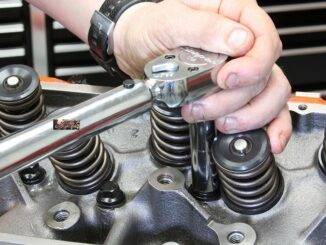
Problems with head bolts, are the number one cause of installation-related gasket failures.
Consequently, no gasket is going to seal well, if you use the wrong procedure to tighten the head bolts.
For regular bolts, make sure all of the bolts are in good condition, free from nicks, corrosion and are not stretched. Never, reuse torque to yield (TTY) bolts. Because, if you do, it’s not unusual for them to break.
So, make sure the torque specs you are using, to tighten the head bolts are the latest, up to date.

And, if that happens you may need to drill out what’s left of the bolt. Even worse, you may have to repair the threads in the hole.
Consequently, head Bolts can break for no apparent reason, leaving you with a leaking or blown head gasket.
Many people never check the accuracy of their torque wrenches. Beam and gauge type wrenches, are less likely to get out of calibration, than the adjustable dial type. At least once a year, you should check your torque wrench for accuracy.
Improper surface finish is probably the second most common reason for gasket failures. This includes surfaces that are too rough and surfaces that are not flat.

Another installer error is, using a sealer on a coated composition head gasket. Some sealers will react with the gasket coating and turn it into goo. If a head gasket requires sealer, it will usually come with the gasket.
Never use a Scotch Brite abrasive pad to, whiz off old gasket residue from a head or block. Abrasives can leave low spots on the surface, that will prevent the head gasket from sealing.
The Following Information Is For, Regular Bolts Only:
- If a head bolt has NOT been subjected to excessive torque. It is most likely reusable a second or even a third time.
- Determining which bolts have been stretched requires, no special tools other than sharp eyes.
Some general suggestions for bolts include:

- Always Inspect all head bolts, to make sure they are in perfect condition. Dirty or damaged threads, can give false torque readings. As well as decrease a bolt clamping force, by as much as 50%!
- Dirty or deformed hole threads in the engine block, can reduce clamping force. The same as dirty or damaged threads on the bolts. Run a bottoming tap down each bolt hole in the block. Clean all holes to remove any debris.
- To be absolutely safe, do NOT reuse (TTY) head bolts.
- Check bolt lengths. Make sure bolt lengths are correct for each hole location (some holes require longer or shorter bolts than others). Replace any bolt that is visibly longer than its companions.
More Head Bolt Suggestions:

- Use hardened steel washers under head bolts in aluminum heads, to prevent galling and help distribute the load. Position the washers, so their rounded or chamfered side faces up.
- Check bolt lengths, to make sure they do not bottom out in blind holes. A bolt that bottoms out will apply little or no clamping force on the head. And, that may allow the gasket to leak. So, to compensate for resurfacing, you may have to install hardened steel washers, under the bolts to raise them up. Or, use a head gasket shim to restore proper head height.
- Lubricate bolt threads as well as the bottom of the bolt head, with 30 weight engine oil. Use a flexible sealer on any bolt threads, that extend into a cooling jacket.
- If a gasket requires retorquing after initial installation. Then, run the engine until it reaches normal operating temperature (usually 10 to 15 minutes), then shut it off. Tighten each head bolt in the same sequence as before, while the engine is still warm. But, if the engine has an aluminum cylinder head or block. Then, do not re torque the head bolts, until the engine has cooled back down to room temperature.
Conclusion
On some applications with retorque style head gaskets, it may be necessary to retorque the head a third time. Usually, after a specified time or mileage interval, due to the design of the engine. Finally, always follow the vehicle manufacturer recommendations.
BY DANNY BENDER



